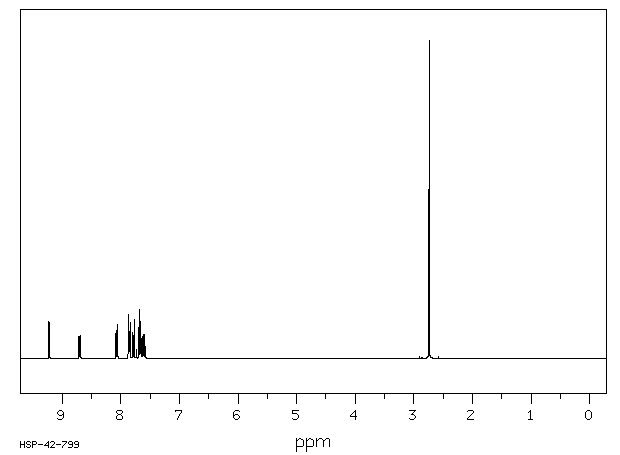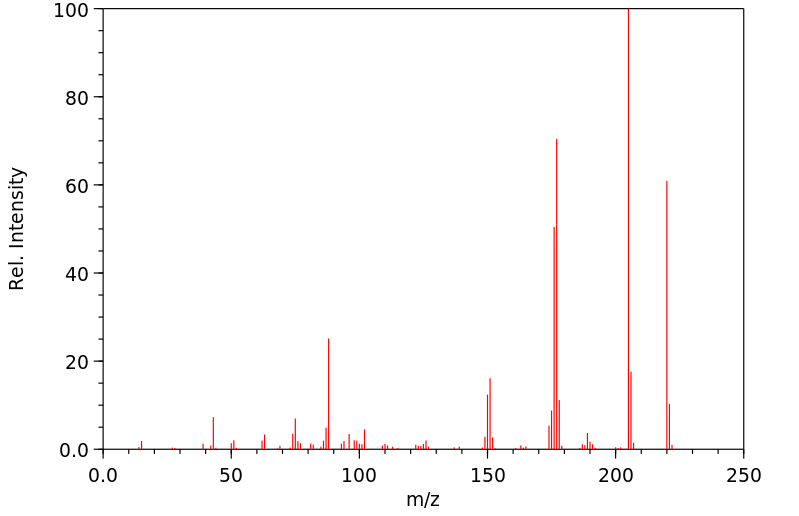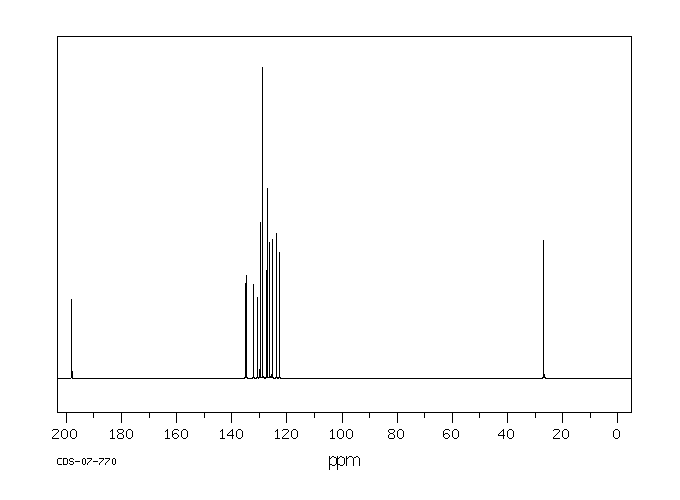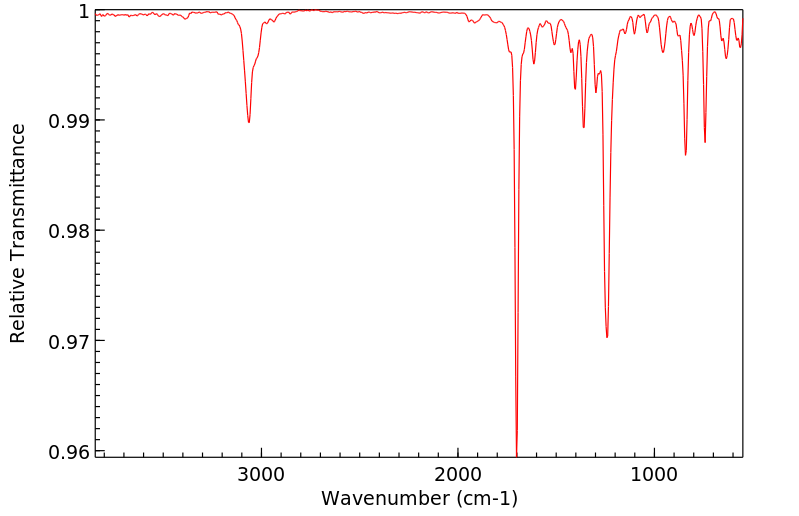3-乙酰基菲 | 2039-76-1
中文名称
3-乙酰基菲
中文别名
3-乙酰菲
英文名称
1-(phenanthren-3-yl)ethanone
英文别名
3-acetylphenanthrene;1-(phenanthren-3-yl)ethan-1-one;1-phenanthren-3-ylethanone
CAS
2039-76-1
化学式
C16H12O
mdl
MFCD00001169
分子量
220.271
InChiKey
JKVNPRNAHRHQDD-UHFFFAOYSA-N
BEILSTEIN
——
EINECS
——
-
物化性质
-
计算性质
-
ADMET
-
安全信息
-
SDS
-
制备方法与用途
-
上下游信息
-
文献信息
-
表征谱图
-
同类化合物
-
相关功能分类
-
相关结构分类
物化性质
-
熔点:67-71 °C (lit.)
-
沸点:172-181 °C(Press: 0.9 Torr)
-
密度:1.164±0.06 g/cm3(Predicted)
-
溶解度:可溶于氯仿(少许)、甲醇(少许)
-
稳定性/保质期:
如果按照规格使用和储存,则不会分解,没有已知的危险反应。应避免与氧化物接触。
计算性质
-
辛醇/水分配系数(LogP):4.1
-
重原子数:17
-
可旋转键数:1
-
环数:3.0
-
sp3杂化的碳原子比例:0.062
-
拓扑面积:17.1
-
氢给体数:0
-
氢受体数:1
安全信息
-
海关编码:2914399090
-
安全说明:S22,S24/25
-
WGK Germany:3
-
危险性防范说明:P261,P280,P305+P351+P338
-
危险性描述:H302,H315,H319,H332,H335
-
储存条件:请将贮藏器密封,并将其存放在阴凉、干燥处。同时,确保工作环境有良好的通风或排气设施。
SDS
SECTION 1: Identification of the substance/mixture and of the company/undertaking
Product identifiers
Product name : 3-Acetylphenanthrene
REACH No. : A registration number is not available for this substance as the substance
or its uses are exempted from registration, the annual tonnage does not
require a registration or the registration is envisaged for a later
registration deadline.
CAS-No. : 2039-76-1
Relevant identified uses of the substance or mixture and uses advised against
Identified uses : Laboratory chemicals, Manufacture of substances
SECTION 2: Hazards identification
Classification of the substance or mixture
Not a hazardous substance or mixture according to Regulation (EC) No 1272/2008
Not a hazardous substance or mixture according to EC-directives 67/548/EEC or 1999/45/EC.
Label elements
The product does not need to be labelled in accordance with EC directives or respective national laws.
Other hazards - none
SECTION 3: Composition/information on ingredients
Substances
Formula : C16H12O
Molecular Weight : 220,27 g/mol
CAS-No. : 2039-76-1
EC-No. : 218-020-5
No components need to be disclosed according to the applicable regulations.
SECTION 4: First aid measures
Description of first aid measures
If inhaled
If breathed in, move person into fresh air. If not breathing, give artificial respiration.
In case of skin contact
Wash off with soap and plenty of water.
In case of eye contact
Flush eyes with water as a precaution.
If swallowed
Never give anything by mouth to an unconscious person. Rinse mouth with water.
Most important symptoms and effects, both acute and delayed
The most important known symptoms and effects are described in the labelling (see section 2.2) and/or in
section 11
Indication of any immediate medical attention and special treatment needed
no data available
SECTION 5: Firefighting measures
Extinguishing media
Suitable extinguishing media
Use water spray, alcohol-resistant foam, dry chemical or carbon dioxide.
Special hazards arising from the substance or mixture
Carbon oxides
Advice for firefighters
Wear self contained breathing apparatus for fire fighting if necessary.
Further information
no data available
SECTION 6: Accidental release measures
Personal precautions, protective equipment and emergency procedures
Avoid dust formation. Avoid breathing vapours, mist or gas.
For personal protection see section 8.
Environmental precautions
Do not let product enter drains.
Methods and materials for containment and cleaning up
Sweep up and shovel. Keep in suitable, closed containers for disposal.
Reference to other sections
For disposal see section 13.
SECTION 7: Handling and storage
Precautions for safe handling
Provide appropriate exhaust ventilation at places where dust is formed.Normal measures for preventive fire
protection.
For precautions see section 2.2.
Conditions for safe storage, including any incompatibilities
Store in cool place. Keep container tightly closed in a dry and well-ventilated place.
Specific end use(s)
A part from the uses mentioned in section 1.2 no other specific uses are stipulated
SECTION 8: Exposure controls/personal protection
Control parameters
Components with workplace control parameters
Exposure controls
Appropriate engineering controls
General industrial hygiene practice.
Personal protective equipment
Eye/face protection
Use equipment for eye protection tested and approved under appropriate government standards
such as NIOSH (US) or EN 166(EU).
Skin protection
Handle with gloves. Gloves must be inspected prior to use. Use proper glove removal technique
(without touching glove's outer surface) to avoid skin contact with this product. Dispose of
contaminated gloves after use in accordance with applicable laws and good laboratory practices.
Wash and dry hands.
The selected protective gloves have to satisfy the specifications of EU Directive 89/686/EEC and
the standard EN 374 derived from it.
Body Protection
Choose body protection in relation to its type, to the concentration and amount of dangerous
substances, and to the specific work-place., The type of protective equipment must be selected
according to the concentration and amount of the dangerous substance at the specific workplace.
Respiratory protection
Respiratory protection is not required. Where protection from nuisance levels of dusts are desired,
use type N95 (US) or type P1 (EN 143) dust masks. Use respirators and components tested and
approved under appropriate government standards such as NIOSH (US) or CEN (EU).
Control of environmental exposure
Do not let product enter drains.
SECTION 9: Physical and chemical properties
Information on basic physical and chemical properties
a) Appearance Form: solid
b) Odour no data available
c) Odour Threshold no data available
d) pH no data available
e) Melting point/freezing Melting point/range: 67 - 71 °C - lit.
point
f) Initial boiling point and no data available
boiling range
g) Flash point no data available
h) Evapouration rate no data available
i) Flammability (solid, gas) no data available
j) Upper/lower no data available
flammability or
explosive limits
k) Vapour pressure no data available
l) Vapour density no data available
m) Relative density no data available
n) Water solubility no data available
o) Partition coefficient: n- no data available
octanol/water
p) Auto-ignition no data available
temperature
q) Decomposition no data available
temperature
r) Viscosity no data available
s) Explosive properties no data available
t) Oxidizing properties no data available
Other safety information
no data available
SECTION 10: Stability and reactivity
Reactivity
no data available
Chemical stability
Stable under recommended storage conditions.
Possibility of hazardous reactions
no data available
Conditions to avoid
no data available
Incompatible materials
Strong oxidizing agents, Strong bases
Hazardous decomposition products
Other decomposition products - no data available
In the event of fire: see section 5
SECTION 11: Toxicological information
Information on toxicological effects
Acute toxicity
no data available
Skin corrosion/irritation
no data available
Serious eye damage/eye irritation
no data available
Respiratory or skin sensitisation
no data available
Germ cell mutagenicity
no data available
Carcinogenicity
IARC: No component of this product present at levels greater than or equal to 0.1% is identified as
probable, possible or confirmed human carcinogen by IARC.
Reproductive toxicity
no data available
Specific target organ toxicity - single exposure
no data available
Specific target organ toxicity - repeated exposure
no data available
Aspiration hazard
no data available
Additional Information
RTECS: Not available
SECTION 12: Ecological information
Toxicity
no data available
Persistence and degradability
no data available
Bioaccumulative potential
no data available
Mobility in soil
no data available
Results of PBT and vPvB assessment
PBT/vPvB assessment not available as chemical safety assessment not required/not conducted
Other adverse effects
no data available
SECTION 13: Disposal considerations
Waste treatment methods
Product
Offer surplus and non-recyclable solutions to a licensed disposal company.
Contaminated packaging
Dispose of as unused product.
SECTION 14: Transport information
UN number
ADR/RID: - IMDG: - IATA: -
UN proper shipping name
ADR/RID: Not dangerous goods
IMDG: Not dangerous goods
IATA: Not dangerous goods
Transport hazard class(es)
ADR/RID: - IMDG: - IATA: -
Packaging group
ADR/RID: - IMDG: - IATA: -
Environmental hazards
ADR/RID: no IMDG Marine pollutant: no IATA: no
Special precautions for user
no data available
SECTION 15: Regulatory information
This safety datasheet complies with the requirements of Regulation (EC) No. 1907/2006.
Safety, health and environmental regulations/legislation specific for the substance or mixture
no data available
Chemical Safety Assessment
For this product a chemical safety assessment was not carried out
SECTION 16: Other information
Further information
Copyright 2013 Co. LLC. License granted to make unlimited paper copies for internal use
only.
The above information is believed to be correct but does not purport to be all inclusive and shall be
used only as a guide. The information in this document is based on the present state of our knowledge
and is applicable to the product with regard to appropriate safety precautions. It does not represent any
guarantee of the properties of the product. Corporation and its Affiliates shall not be held
liable for any damage resulting from handling or from contact with the above product. See
and/or the reverse side of invoice or packing slip for additional terms and conditions of sale.
上下游信息
-
上游原料
中文名称 英文名称 CAS号 化学式 分子量 —— 3-isopropylphenanthrene 33240-32-3 C17H16 220.314 苯乙酮 acetophenone 98-86-2 C8H8O 120.151 -
下游产品
中文名称 英文名称 CAS号 化学式 分子量 —— phenanthren-2-yl-oxoacetaldehyde 1710-28-7 C16H10O2 234.254 3-乙基菲 3-ethylphenanthrene 1576-68-7 C16H14 206.287 —— tert-butyl 3-phenanthryl ketone 856979-35-6 C19H18O 262.351 3-菲羧醛 phenanthrene-3-carbaldehyde 7466-50-4 C15H10O 206.244 —— 3-isopropylphenanthrene 33240-32-3 C17H16 220.314 2-[3]菲基-乙醇 2-[3]phenanthryl-ethanol 1000561-98-7 C16H14O 222.287 9-乙基菲 9-ethylphenanthrene 3674-75-7 C16H14 206.287 1-菲-3-基乙醇 1-(3-phenanthryl)ethanol 7494-58-8 C16H14O 222.287 3-菲甲酸 phenanthrene-3-carboxylic acid 7470-14-6 C15H10O2 222.243 —— 3-(propyl-1-en-2-yl)phenanthrene 71113-98-9 C17H14 218.298 —— 1-[3]phenanthryl-3-piperidino-propan-1-one 119569-03-8 C22H23NO 317.431 —— 3-sec-butyl-phenanthrene 109245-24-1 C18H18 234.341 2-菲-3-基乙酸 3-Phenanthrylacetic acid 84306-76-3 C16H12O2 236.27 —— phenantrene-3-carboxylic acid chloride 96403-16-6 C15H9ClO 240.689 —— 3-phenanthroyl-trifluoroacetone 95780-08-8 C18H11F3O2 316.279 —— 2-hydroxy-2-(phenanthryl-(3))-propane 42454-87-5 C17H16O 236.313 —— 1-(phenanthren-3-yl)ethanone oxime 5968-50-3 C16H13NO 235.285 —— (E)-3-Acetylphenanthrene oxime 5968-50-3 C16H13NO 235.285 —— 3-(3-Chlorophenyl)-1-phenanthren-3-ylprop-2-en-1-one —— C23H15ClO 342.825 —— 3-(3-Chlorophenyl)-1-(3-phenanthryl)prop-2-en-1-one —— C23H15ClO 342.8 - 1
- 2
反应信息
-
作为反应物:描述:参考文献:名称:Preparation of Polycyclic Azaarenes by an Extended Pomeranz-Fritsch Procedure摘要:对Pomeranz-Fritsch程序的扩展被评估为获得某些多环氮芳烃的一种途径。芳香醛与2-氨基乙醇的二甲基和二乙基缩醛反应,得到的亚胺还原为胺,然后进行托磺酰化,得到的磺酰胺在一系列酸性条件下处理。两种萘醛分别导致了苯并[f]异喹啉和苯并[h]异喹啉,总产率为13%和36%。菲-9-甲醛和菲-3-甲醛分别得到二苯并[f,h]异喹啉和萘并[2,1-g]异喹啉,作为主要的四环产品。从芘-1-甲醛出发的类似反应序列未能获得五环产品。DOI:10.1055/s-2007-983744
-
作为产物:描述:2-氨基-5-溴苯乙酮 在 1,3-双(二苯基膦)丙烷 、 potassium carbonate 、 对甲苯磺酸 、 potassium iodide 、 palladium dichloride 、 sodium nitrite 作用下, 以 水 、 N,N-二甲基甲酰胺 、 乙腈 为溶剂, 反应 7.5h, 生成 3-乙酰基菲参考文献:名称:Pd-catalyzed tandem homocoupling–aldol–dehydration of ortho-acylphenyl iodides摘要:一种Pd催化的级联Ullmann偶联-醛缩-脱水反应可将邻-酰基苯基碘化物转化为具有广泛官能团耐受性的秋水仙碱类似物。DOI:10.1039/c4ra02055c
文献信息
-
Primary Amines by Transfer Hydrogenative Reductive Amination of Ketones by Using Cyclometalated Ir<sup>III</sup>Catalysts作者:Dinesh Talwar、Noemí Poyatos Salguero、Craig M. Robertson、Jianliang XiaoDOI:10.1002/chem.201303541日期:2014.1.3Cyclometalated iridium complexes are found to be versatile catalysts for the direct reductive amination (DRA) of carbonyls to give primary amines under transfer‐hydrogenation conditions with ammonium formate as both the nitrogen and hydrogen source. These complexes are easy to synthesise and their ligands can be easily tuned. The activity and chemoselectivity of the catalyst towards primary amines
-
A Three-Component Strategy for Benzoselenophene Synthesis under Metal-Free Conditions Using Selenium Powder作者:Penghui Ni、Jing Tan、Wenqi Zhao、Huawen Huang、Fuhong Xiao、Guo-Jun DengDOI:10.1021/acs.orglett.9b00739日期:2019.5.17An efficient three-component benzoselenophenes formation has been developed from substituted indoles, acetophenones, and selenium powder under metal-free conditions. 2-Aryl indoles played an important role to promote benzoselenophene formation from acetophenone derivatives and selenium powder. One C–C and two C–Se bonds were selectively formed to provide 40 new benzoselenophenes in good yields.
-
Pyrrolo-imidazo[1,2-<i>a</i>]pyridine Scaffolds through a Sequential Coupling of <i>N</i>-Tosylhydrazones with Imidazopyridines and Reductive Cadogan Annulation, Synthetic Scope, and Application作者:Kena Zhang、Abderrahman El Bouakher、Helene Levaique、Jerome Bignon、Pascal Retailleau、Mouad Alami、Abdallah HamzeDOI:10.1021/acs.joc.9b02018日期:2019.11.1of 3-phenyl-1H-pyrrolo-imidazo[1,2-a]pyridine backbone is described. The reaction starts from the coupling between N-tosylhydrazones and 2-chloro-3-nitroimidazo[1,2-a]pyridines leading to the formation of 3-nitro-2-(arylvinyl)imidazo[1,2-a]pyridine derivatives. Optimization of Cadogan-reductive conditions allowed the conversion of the obtained nitro derivative to a new scaffold of the type 3-aryl-描述了构建3-苯基-1H-吡咯并咪唑并[1,2-a]吡啶骨架的新策略。反应从N-甲苯磺酰hydr与2-氯-3-硝基咪唑并[1,2-a]吡啶之间的偶联开始,导致3-硝基-2-(芳基乙烯基)咪唑并[1,2-a]吡啶衍生物的形成。Cadogan还原条件的优化允许将获得的硝基衍生物转化为新的3-芳基-1H-吡咯并咪唑并[1,2-a]吡啶型支架。该方法在面向多样性的合成中提供了对新文库的快速访问,该合成旨在以有效的方式生成具有大结构多样性的小分子。筛选出新产生的化合物的生物活性后,鉴定出了一种新的有前途的化合物5cc,
-
Metal‐Free Three‐Component Selenopheno[2,3‐ <i>b</i> ]indole Formation through Double C−H Selenylation with Selenium Powder作者:Penghui Ni、Jing Tan、Wenqi Zhao、Huawen Huang、Guo‐Jun DengDOI:10.1002/adsc.201901023日期:2019.12.3A facile metal‐free entry to novel selenopheno[2,3‐b]indole motif is described. The three‐component assembly of indoles, aromatic ketones, and selenium powder is enabled by the IBr‐promoted highly selective double C–H selenylation/annulation. This protocol provides a novel access to a diverse variety of selenopheno[2,3‐b]indoles with good efficacy and broad functional group compatibility.
-
Enantioselective Synthesis of α-Allyl Amino Esters via Hydrogen-Bond-Donor Catalysis作者:Andrew J. Bendelsmith、Seohyun Chris Kim、Masayuki Wasa、Stéphane P. Roche、Eric N. JacobsenDOI:10.1021/jacs.9b05556日期:2019.7.24diastereoselec-tive synthesis of α-allyl amino esters. The optimized protocol provides access to N-carbamoyl-protected amino esters via nucleophilic allyla-tion of readily accessible α-chloro glycinates. A variety of useful α-allyl amino esters were prepared-including crotylated products bearing vicinal stereocenters that are inaccessible through enolate alkylation-with high enantioselectivity (up to 97% ee)
表征谱图
-
氢谱1HNMR
-
质谱MS
-
碳谱13CNMR
-
红外IR
-
拉曼Raman
-
峰位数据
-
峰位匹配
-
表征信息
同类化合物
(R)-2,2'',3,3''-四氢-6,6''-二-9-菲基-1,1''-螺双[1H-茚]-7,7''-二醇
(6,6)-苯基-C61己酸甲酯
高雌二醇
马兜铃酸钠
马兜铃酸盐
马兜铃酸C
马兜铃酸B
马兜铃酸(1:1MIXTUREOFARISTOLOCHICACIDIANDARISTOLOCHICACIDII)
马兜铃酸 Ia
马兜铃酸 IVa
马兜铃酸
颜料黑32
颜料红179
颜料红178
颜料红149
颜料红123
顺式-菲-1,2-二醇-3,4-环氧化物
顺式-苯并(a)屈-11,12-二醇-13,14-环氧化物
雷公藤酚A
镁二(1,4,5,6,7,16,17,18,19,19,20,20-十二氯六环[14.2.1.14,7.02,15.03,8.09,14]二十-5,9,11,13,17-五烯-11-磺酸酯)
钩大青酮
钩大青酮
钙(2+)12-羟基十八烷酸酯
酒石酸布托诺啡
那布扶林
还原红32
足球烯
贝那他汀B
贝母兰素
萘并[2,3-b]荧蒽
萘并[2,1-e][1]苯并二硫杂环戊烷
萘并[2,1-C:7,8-C']二菲
萘并[1,2-e][2]苯并呋喃-1,3-二酮
萘并[1,2-b]屈
萘并[1,2-a]蒽
萘并[1,2-B]菲-6-醇
萘二(六氯环戊二烯)加合物
萘,8-溴-1,2,3-三(1,1-二甲基乙基)-6-甲基-
菲醌单缩氨基硫脲
菲醌
菲并[9,10]呋喃
菲并[9,10-e]醋菲烯
菲并[4,5-bcd]噻吩
菲并[4,5-bcd]呋喃-3-醇
菲并[4,3-d]-1,3-二噁唑-5-羧酸,10-羟基-9-甲氧基-6-硝基-
菲并[3,2-b]噻吩
菲并[2,1-d]噻唑
菲并[2'',1'',10'':4,5,6;7'',8'',9'':4',5',6']二异喹啉并[2,1-a:2',1'-a']二萘嵌间二氮杂苯-8,13-二酮
菲并(3,4-b)噻吩
菲并(1,2-b)噻吩










